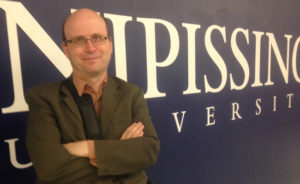‘Mill Colonialism’ in Sturgeon Falls

By Catherine Murton Stoehr
Stephen High had been teaching history at Nipissing University for only two months in 2002 when the news broke that the Sturgeon Falls mill was closing. His students, one of whom had a parent working at the mill, urged him to write about it. High, now at Concordia University, spoke in North Bay this week about the life and death of the Sturgeon Falls Mill and reflected on its role in the colonization of Northern Ontario.
Already an established scholar of the effects of deindustrialization in other parts of North America, High couldn’t refuse his student’s request. But while sympathetic to the mill workers’ struggles he didn’t shy away from shining a light on the mill’s role in the long history of Canadian colonialism.
“When we think about the spread of non-indigenous communities west we think of farmers, but in Northern Ontario settlement spread through ‘mill colonialism’,”
Over the course of its life the Sturgeon Mill’s owners pushed for more access to Nipissing First Nation’s land, advocated for the construction of the railway line that runs through Nipissing First Nation, demanded access rights to build dams on rivers, and dumped pollutants into local waterways.
As the title of Professor High’s forthcoming book One Job Town: Work, Belonging and Betrayal in Northern Ontario suggests, the mill gave birth to the town of Sturgeon Falls and supported its families across generations with a policy of hiring the children of employees. Its highest point of employment was in the 1960s. By the 1990s the mill’s fortunes had declined; it faced a possible closure but was saved when Bob Rae’s NDP government assisted its transition to recycled paper production. When the end came in 2002 the mill was still profitable and had contracts for all of its production for nine months into the future. Those contracts were cancelled and the new owners, Weyerhaeuser, announced the closure to the employees at a mass gathering staffed by out of town security.
Professor High expressed frustration at his own inability to uncover stories about the relationship between the mill and local First Nations but suggested that one of Weyerhaeuser’s final acts may be partially to blame. During the closure Weyerhaeuser, who had only owned the mill for three years, brought in a shredding truck and destroyed all of the records of its 100 year history, including possible correspondence from Nipissing and Dokis First Nations. The mills’ workers, who were in a better position than anyone to understand how much history shredding the records would erase, actually stopped the shredding truck from entering the grounds on its first attempt.
High argued that northern Ontario mill towns were “racialized as white and First Nations peoples weren’t invited”. Despite this, at least 10 First Nations people had worked at the mill since the 1950s. In one interview, Randy Restoule, the son of a Dokis First Nation citizen who worked for the mill until its end said that he didn’t feel excluded or set apart from the other workers. High’s interviews with non-indigenous employees confirmed that they saw their Anishinaabe co-workers as part of the group.
High still struggles with how to show respect for the mill workers he writes about while being honest about how the mill and its employees disadvantaged Nipissing and Dokis people.
“It’s not people’s fault where they’re born but they are implicated [in colonialism]. Settler colonialism is closer to the surface in places like North Bay and Sturgeon Falls than it is among capital elites in Toronto and Montreal,” said High noting that bearing responsibility for colonial injustices is personal, High concluded “My father’s a railwayman, so I’m a part of this too.”


